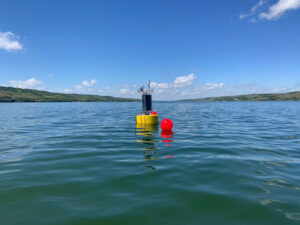Thermo Orion Dual Star Benchtop pH/ISE Meters
Features
- Dual channel with simultaneous displayed measurements
- Star stirrer probe can be controlled directly from the meter
- 1000 point data logging with time and date stamping
- Free ground shipping
- Expedited repair and warranty service
- Lifetime technical support
- More
Overview
Improve sample measurements with the Thermo Scientific Orion Dual Star pH/ISE dual channel benchtop meter. The Orion Dual Star meter shows the results of two channels simultaneously or displays large individual measurements on a large, backlit graphic display.
Multiparameter
Measure pH, ion concentration (ISE), mV, relative mV or ORP with temperature using the meter’s two BNC, reference pin-tip and ATC temperature inputs. The onscreen stability indicator is designed to alert fluctuations or instability of critical measurements.
Benefits
- Quickly toggle to show both channels simultaneously or each channel separately
- Easy to follow onscreen text prompts for calibration and setup menus available in a multi-language user interface with English, Spanish, French, German or Italian options
- Enjoy quick meter setup and data entry with a numeric keypad and menu-specific function keys
- Perform up to a 6 point pH calibration with automatic recognition for USA/NIST and EURO/DIN buffers with the option to manually input custom buffer values
- Perform up to a 6 point ion concentration (ISE) calibration with non-linear auto-blank and low-concentration stability options or use incremental methods for single/double known addition and single/double known subtraction
- Smart Stability and Smart Averaging functions are designed to automatically compensate for measurement conditions
- EZ Startup menu helps to facilitate quick and easy first-time meter setup
| pH Range | -2.000 to 19.999pH |
| pH Resolution pH | 0.1, 0.01, 0.001pH |
| pH Relative Accuracy | ±0.002pH |
| mV Range mV | ±1999.9mV |
| Relative mV Range | ±1999.9mV |
| ORP Range | ±1999.9mV |
| mV Resolution | 0.1mV |
| mV Relative Accuracy | ±0.2 mV or ±0.05% of reading whichever is greater |
| ISE Range | 0.0001 to 19900 with selectable units of ppm, Molar, mg/L, % or unit-less |
| ISE Resolution | 0.0001 minimum, 1 to 3 significant digits (user selectable) |
| ISE Relative Accuracy | ±0.2 mV or ±0.05% of reading whichever is greater |
| Advanced ISE Functions | Segmented (point-to-point) slope, non-linear selectable auto-blank, low concentration range stability, incremental techniques including single known addition, single known subtraction, double known addition and double known subtraction |
| Calibration Options | pH with calibration editing option, ion concentration (ISE) with calibration editing option, relative mV (RmV), ORP and temperature |
| pH Calibration Points | 1 to 6 |
| ISE Calibration Points | 2 to 6 |
| RmV & ORP Calibration Points | 1 point relative mV (RmV) mode, 1 point ORP mode |
| Isopotential Point | 7.000pH (adjustable), 1.000 ISE (adjustable) |
| Temperature Range | -5.0 to 105.0 °C, 22.0 to 221.0 °F |
| Temperature Resolution | 0.1°C, 0.1°F |
| Temperature Relative Accuracy | ±0.1°C |
| Temperature Selection | Manual or automatic with ATC temperature probe |
| Temperature Probe Calibration | 1 point temperature offset calibration |
| Channels | 2 |
| Display Type | Graphic LCD with backlight |
| Backlight Option | Yes, adjustable |
| Keypad | Numeric with menu-specific function keys and dual purpose scroll/shortcut keys |
| Measurement Modes | pH, mV, relative mV (RmV), ORP or ion concentration (ISE) with temperature |
| Stability | Smart Stability and Smart Averaging |
| Data Management Details | Transfer single, range or all data points to printer or computer |
| Data Points | 1000 with date and time stamp |
| Log Function Type | Automatic data logging with Auto-Read, On Ready, At Timed Intervals, Value Change In Measurement and Timed Reading measure modes; manual data logging with Continuous measure mode |
| Memory | Non-volatile memory preserves data log, calibration log and meter settings |
| Alarm Output | High/low limit alarm |
| Methods | 10 per channel with password protection |
| Languages | English, Spanish, French, Italian and German |
| Inputs | Two BNC (pH, ORP or ion selective electrode), two pin-tip (reference electrode), two 8 pin MiniDIN (ATC temperature probe), stirrer input (stirrer probe) |
| Outputs | USB, RS232 |
| Compatible Probe Types | pH electrode, ORP electrode, ion selective electrode (ISE), reference half-cell electrode, ATC temperature probe, stirrer probe |
| Power Supply | Universal AC adapter (included) |
| AC Adapter | Universal 50-60 Hz, 100-240 VAC power adapter (Cat. No. 1010003) |
| Warranty | 3 year meter warranty |
| IP Rating | IP-54 |
| Certifications Compliance | CE, TUV 3-1, FCC Class A |
| Temperature Operating | 5 to 45°C (ambient), 41° to 113°F (ambient) |
| Relative Humidity Range | 5 to 85 %, non-condensing |
| Dimensions LxWxH | 24 cm x 17 cm x 9 cm (9.5" x 6.7" x 3.5") |
| Weight | 0.9 kg, 2 lbs |
In The News
Ocean acidification: University of Washington's giant plastic bags help control research conditions
With oceans becoming more acidic worldwide, scientists are getting creative in designing experiments to study them. For example, one group at the University of Washington is using giant plastic bags to study ocean acidification. Each bag holds about 3,000 liters of seawater and sits in a cylinder-like cage for stability. The group at UW, made up of professors and students, is controlling carbon dioxide levels in the bags over a nearly three-week period, during which they are looking at the effects of increased acidity on organisms living near the San Juan Islands. “These mesocosms are a way to do a traditional experiment you might do in a lab or classroom,” said Jim Murray, professor of oceanography at the University of Washington.
Read MoreNOAA Alaska buoy network to monitor North Pacific ocean acidification
National Oceanic and Atmospheric Administration scientists detected signs of ocean acidification in the waters that hold the vulnerable and valuable fisheries of the North Pacific off the coast of Alaska, but they only had a snapshot of the action. “We know that in this place were important commercial and subsistence fisheries that could be at risk from ocean acidification,” said Jeremy Mathis, a NOAA Pacific Marine Environmental Laboratory researcher and professor at the University of Alaska Fairbanks. To understand how ocean acidification affects the North Pacific, NOAA scientists created a mooring network that collects constant in situ data on parameters contributing to acidification. They hope it will reveal seasonal trends and patterns left out by their snapshots.
Read MoreCombating Water Insecurity in Saskatchewan with Real-Time Data
The prairies of Saskatchewan can be described as one of the least water-secure parts of Canada, making water quality monitoring essential for informed resource management in a region already facing water insecurity. While natural physical properties worsen some of the poor water quality conditions in the region, others are connected to land use. Having grown up spending summers on the shores of Lake Huron, Helen Baulch, an associate professor at the School of Environment and Sustainability at the University of Saskatchewan , has always been dedicated to the protection of water resources. Looking back fondly at her childhood playing along the shore, Baulch also recalls the invasion of quagga mussels during her teenage years and watching the lake change as a result.
Read More












































































